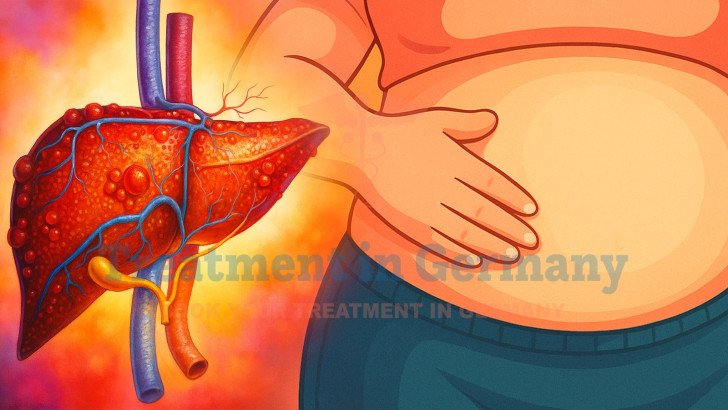
Ascites in liver cancer often reflects disease progression and peritoneal involvement. Learn how it develops, how it's diagnosed, and how imaging and fluid analysis guide care.
Why Ascites Develops in Patients with Liver Cancer
Ascites in liver cancer refers to the accumulation of fluid within the abdominal cavity, often indicating disease progression or worsening liver dysfunction. This condition, known as abdominal fluid buildup, is a common manifestation in patients with advanced liver cancer symptoms. It may develop gradually or rapidly and is usually a sign that the liver is unable to maintain normal fluid balance due to tumor invasion or vascular obstruction.
In the context of cancer, ascites is more than a symptom, it serves as a clinical indicator of changes in hepatic blood flow, protein synthesis, and lymphatic drainage. When detected, it typically prompts further evaluation to determine whether the fluid is caused by portal hypertension, peritoneal carcinomatosis, or other cancer-related mechanisms.
The presence of fluid in abdomen cancer patients often results from a combination of physiological disturbances caused by the liver tumor or surrounding complications. One of the leading causes is portal hypertension, a condition in which elevated pressure in the portal vein pushes plasma from blood vessels into the peritoneal space. This can occur when the tumor compresses or infiltrates hepatic vasculature.
Another contributing factor is hypoalbuminemia, where reduced production of albumin, due to impaired liver function, lowers plasma oncotic pressure. This imbalance allows fluid to escape the bloodstream more easily into surrounding tissues, including the abdomen.
In cases of peritoneal carcinomatosis, cancer cells spread to the peritoneum, triggering inflammation and increased capillary permeability. This produces malignant ascites, characterized by fluid rich in proteins and cancer cells. Additionally, lymphatic obstruction from tumor burden may impair fluid drainage, further worsening ascitic accumulation.
These combined mechanisms contribute to the development of ascitic fluid and often signal advanced or metastatic disease in liver cancer patients.
The symptoms of cancer-related ascites vary based on the volume and speed of fluid accumulation. In many patients, the earliest sign is abdominal swelling in cancer, often accompanied by bloating, discomfort, and a feeling of heaviness. Other common signs include:
These symptoms can severely impact a patient's quality of life and functional capacity. In German healthcare centers, symptom evaluation is guided by a multidisciplinary approach involving German specialists in hepatology, oncology, and radiology.
How Ascites Is Diagnosed in Patients with Liver Cancer
The diagnosis of ascites begins with a physical exam, where clinicians look for clinical signs such as shifting dullness and fluid wave. However, definitive diagnosis relies on advanced oncology diagnostic imaging and fluid sampling.
Initial confirmation is typically performed using ultrasound, which detects even small amounts of fluid. For a more comprehensive assessment, CT scans, MRI, or PET scans are used. These imaging modalities help visualize liver structure, identify tumor spread, and evaluate vascular involvement.
To analyze the nature of the fluid, a paracentesis procedure is performed. In this process, a needle is inserted into the abdominal cavity to withdraw ascitic fluid for laboratory testing. This fluid is analyzed for:
The combined findings from diagnostic imaging and fluid analysis provide crucial insights into cancer staging and liver function. MRI and CT scans not only quantify fluid but also detect structural abnormalities, lymph node enlargement, and potential metastasis.
In German healthcare centers, this diagnostic process is led by multidisciplinary teams who specialize in interpreting complex cases. Imaging is used to track tumor size, monitor vascular changes, and evaluate treatment response. In advanced cases, PET scans may be employed to identify metabolic activity of peritoneal deposits, helping differentiate benign from malignant lesions.
Laboratory tests also guide decisions regarding nutritional support, treatment eligibility, and fluid management, all of which are essential for long-term care planning.
Monitoring and Reassessing Ascites in Ongoing Cancer Management
Patients with ascites in liver cancer require ongoing monitoring to assess fluid reaccumulation, response to therapy, and symptom progression. This includes:
If fluid returns rapidly, patients may benefit from long-term drainage catheters. Regular reassessment is also necessary to identify complications such as spontaneous bacterial peritonitis, which requires immediate antibiotic therapy.
In many German healthcare centers, patients follow structured pathways guided by personalized treatment plans, ensuring consistent care and clinical oversight.
Management Strategies for Ascites Caused by Liver Cancer
The primary goal in managing abdominal fluid buildup is to relieve symptoms, maintain comfort, and preserve functional independence. Management options include:
When malignant ascites results from peritoneal carcinomatosis, symptom control becomes the primary focus. In such cases, German specialists often recommend supportive care measures that address quality of life while continuing targeted cancer therapies.
Access to Specialized Diagnostic Care for International Patients
Many international patients benefit from collaborative care models where teams of German specialists offer diagnostic clarity, advanced imaging, and customized evaluations. TIG (Treatment in Germany) provides seamless coordination and complete logistic arrangements for patients, including travel, lodging, and medical visa support (if needed). The service, accessible through www.treatmentingermany.de, ensures that international patients can access appointments with hepatologists, oncologists, and radiologists without administrative delays.
Through structured referral systems and access to the latest imaging tools, patients from abroad receive efficient and comprehensive evaluations, including CT scans, MRI, and PET scans, aligned with international clinical guidelines.
🌍Why Patients Worldwide Prefer Our Medical Services in Germany – Key Benefits Explained:
Frequently Asked Questions
What is ascites in liver cancer?
It refers to the accumulation of fluid in the abdomen due to liver dysfunction, vascular changes, or cancer spread.
What causes fluid buildup in abdominal cancer patients?
Common causes include portal hypertension, low albumin levels, lymphatic blockage, and peritoneal carcinomatosis.
Is ascitic fluid always malignant in liver cancer?
No. It can be transudative from vascular changes or exudative when cancer spreads to the peritoneum.
How is ascites diagnosed in liver cancer patients?
Diagnosis involves imaging with CT scans or MRI, followed by a paracentesis procedure to analyze the fluid.
What does SAAG mean in fluid analysis?
SAAG (serum-ascites albumin gradient) helps determine if the fluid is due to portal hypertension or malignancy.
How is ascites managed in advanced liver cancer?
Management includes therapeutic paracentesis, diuretics, nutritional support, and symptom-directed care.
Do international patients have access to these services?
Yes. TIG (Treatment in Germany) at www.treatmentingermany.de helps international patients with complete logistical arrangements.
Kindly complete the form below, and our dedicated team will reach out to you promptly. We look forward to connecting with you soon!
Trierer Straße, 56072 Koblenz, Germany
.webp)
.webp)
 (1).webp)
 (1).webp)

.webp)
.webp)
 (1).webp)
 (1).webp)
